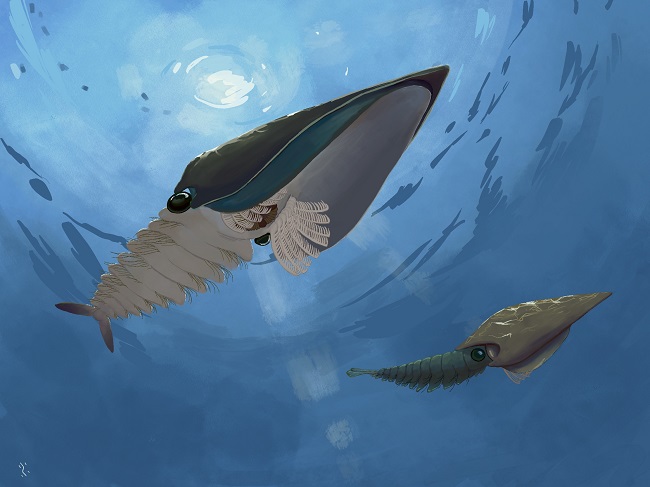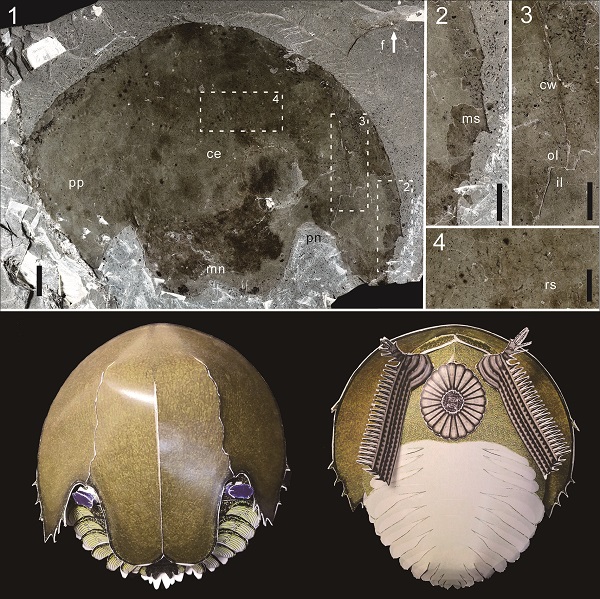 中国科学院战略性先导科技专项(B类)
中国科学院战略性先导科技专项(B类)
关键地史时期生物与环境演变
Processes and Mechanisms of Organismal and Environmental Evolution during the Critical Intervals in Earth Historye
As enigmatic stem-group euarthropods and some of the earliest apex predators, the radiodonts are iconic animals of the Cambrian Explosion. Distinctive features of this group include a head with a pair of frontal appendages and a radial oral cone, and a trunk with swimming flaps and setal structures. As one of the two main lineages of radiodonts, the hurdiids are characterized by a tripartite cephalic carapace composed of a dorsal central element and paired lateral elements, a pair of frontal appendages bearing elongate blade-shaped endites and a tetraradial oral cone.
Our understanding of the morphological and ecological diversity of hurdiids has greatly improved in recent years, which has revealed the important roles of hurdiids in the complex Cambrian ecosystems. Although the Hurdiidae has a cosmopolitan distribution in the Cambrian, their Miaolingian occurrences are restricted to Laurentia and the knowledge of their diversity during this time has potentially been biased and incomplete.
Recently, leading by Prof. ZHAO Fangchen, postgraduate SUN Zhixin and Dr. ZENG Han from the Nanjing Institute of Geology and Palaeontology, Chinese Academy of Sciences (NIGPAS) described two hurdiid genera from the middle Cambrian at Shandong province, which represent the first discoveries of hurdiid radiodonts in North China. Relevant results have been published in the journals Palaeogeography, Palaeoclimatology, Palaeoecology and Journal of Paleontology.
Cordaticaris striatus gen. et sp. nov. was collected from the middle Cambrian (Miaolingian, Drumian) Zhangxia Formation in Linyi City, Shandong Province. This new taxon is characterized by a heart-shaped central element with linear ornament, frontal appendages equipped with nine blade-like endites including seven subequal elongate endites, a node-bearing ‘peytoia’-type oral cone, and a trunk covered with rows of setal structures. Cordaticaris not only enriches the taxonomic diversity of Hurdiidae, but also further exhibits the great morphological disparity of hurdiids. The discovery of soft-bodied fossils in the Zhangxia Formation also stresses the great potential of the Miaolingian strata of North China for the preservation of non-biomineralized organisms.
Cambroraster, first discovered from the Burgess Shale in 2019, is readily distinguishable from other hurdiid taxa by its central head sclerite with deep posterior notches, a rounded anterior margin, and posterolateral processes bearing multiple spines. New specimens of Cambroraster were collected from the Upper Shale Member of the Mantou Formation (uppermost Wuliuan) in Weifang City, Shandong Province. This discovery suggests that Cambroraster had dispersed over a wide biogeographic range, and indicates that the Upper Shale Member of the Mantou Formation is a promising Burgess Shale-type Lagerstatte.
This work is financially supported by the Strategic Priority Research Program (B) of Chinese Academy of Sciences, National Natural Science Foundation of China, Jiangsu Basic Research Project, and the State Key Laboratory of Palaeobiology and Stratigraphy.
Reference: Sun, Z.X., Zeng, H., Zhao, F.C.*, 2020. A new middle Cambrian radiodont from North China: implications for morphological disparity and spatial distribution of hurdiids. Palaeogeography. Palaeoclimatology, Palaeoecology 558:109947. https://doi.org/10.1016/j.palaeo.2020.109947.
Sun, Z.X., Zeng, H., Zhao, F.C.*, 2020. Occurrence of the hurdiid radiodont Cambroraster in the middle Cambrian (Wuliuan) Mantou Formation of North China. Journal of Paleontology, https://doi.org/10.1017/jpa.2020.21.

The central element and oral cone of Cordaticaris striatus, and stratigraphic and paleogeographic distribution of hurdiid radiodonts

Artistic reconstruction of Cordaticaris striatus on the Cambrian sea(Image Credit HUO Xiuquan)

Cambroraster cf. falcatus from the Cambrian (Miaolingian, Wuliuan) Upper Shale Member, Mantou Formation in Weifang City, Shandong Province, North China, and the dorsal (left) view and ventral (right) view of a Cambroraster model